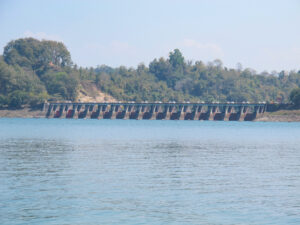by Soumik Deb Simanto
As a student researcher at the Environmental Conservation Lab and an avid Bangladeshi, I am pleased to be studying the social, cultural, and environmental impacts ignited by the Kaptai Dam in the Karnaphuli River. The dam was, and still is a matter of concern in that region and a nightmare for the Indigenous people of the Chittagong Hill Tracts. The People fought against this historical injustice perpetuated by the political powers then and have been resisting the autocratic armed forces in the present days.
The dam’s history goes back to the 1950s when the Pakistan government with the help and funds from the USA through United States Agency for International Development (USAID) begins the construction of the dam on the Karnaphuli River to produce hydropower and meet the need for electricity of the people in the plain. The dam adds approximately 5% of electricity to the total national production of electricity. Hydropower was and still is a ray of hope in meeting global needs for electricity as an alternative and sustainable energy source that replaces fossil fuel-based production of electricity. The tradition of the lack of impact assessment and environmental assessment has been an issue for this alternative energy source, and that is exactly what happened in the construction of the Kaptai Dam project.

The history continues as the people of the Chittagong Hill Tracts are still being displaced from their ancestral lands as they were in the 1960s. Approximately 100,000 Indigenous People were displaced from their homeland and lost their farmland due to the construction of the dam. The fake assurance of the government about giving compensation for the lost farmland and houses of the people continues to push them into the nearby Indian states like Assam and Tripura.
The cultural and environmental impacts and degradation caused by the Kaptai dam went unnoticed. The loss of biodiversity, forests, and farmlands had a profound impact on the Indigenous culture of Jum farming, which is an Indigenous method of farming in the hills. The historical analysis of the Kaptai Dam does not properly acknowledge or identify the harms caused by the construction of the dam. The reality is that the dam not only destroyed the biodiversity but also culturally destroyed and displaced a large group of Indigenous people who were being forced to leave their ancestral land, losing their cultural landscape.
As a result of the construction of the dam, the Indigenous people opposed the Bangladeshi Government after the country gained independence in 1971. After almost 22 years of armed conflicts between the administration and the Indigenous people, a peace treaty was signed in 1997 to put out the fire of revolution. But the discrimination, torture, displacement, and killing of Indigenous people and the burning of their houses are still a crisis that is affecting the communities.
Despite the tragic history of human development in that region, the Indigenous people of the Chittagong Hill Tracts are still facing eviction, death threats, lawsuits, and lengthy judicial processes as a further consequence from both the government and the Bengali settlers. The current human developments like land grabbing by the Bengali settlers and the unconsented construction of hotels on Indigenous lands at the Chittagong Hill Tracts are making the political geography of the region even more complicated.
The misinformation and lack of proper and documentation surrounding the historical injustices done to the Indigenous people of this country must be exposed to the current generation. Only when the impacts of hydro developments and other sustainable energy sources are discussed, can displacement from ancestral homelands be stopped.
Resources and Further readings:
Chakma, N. (2021, November 01). The Kaptai Dam: A Story of disenfranchisement, displacement, and destruction. International Rivers. https://www.internationalrivers.org/news/the-kaptai-dam-a-story-of-disenfranchisement-displacement-and-destruction/
CHT Accord that was created in 1997: https://www.pcjss.org/cht-accord-of-1997/
January-February 2022: Report on human rights situation of Chittagong Hill Tracts. https://www.pcjss.org/january-february-2022-report-on-human-rights-situation-of-chittagong-hill-tracts/
Ahmed, H. S. (2019). The Politics of Indigeneity and the Jumma struggle for land and recognition. The Daily Star. https://www.thedailystar.net/star-weekend/longform/news/the-politics-indigeneity-and-the-jumma-struggle-land-and-recognition-1805566
Jnan. (2018). Ethnic cleansing in Bangladesh: The Chittagong Hill Tracts? The Asia Dialogue. https://theasiadialogue.com/2018/03/08/ethnic-cleansing-in-bangladesh/
Global Defense Corp. (2020). Hidden truth: Rape, violence, and brutality in the Chittagong Hill Tracts by Bangladesh Military. https://www.globaldefensecorp.com/2020/02/29/hidden-truth-rape-violence-and-brutality-in-the-chittagong-hill-tracts-by-bangladesh-military/

